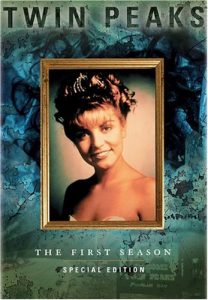“Twin Peaks” has gotten name-dropped so often over the past quarter century in reviews or analyses of my favorite shows that I figured I might as well bear down and watch the darn thing. With this being the 25th anniversary of the series, and with a continuation coming up on Showtime in 2016, and with the series as we know it available for free on Hulu and CBS.com, now’s as good a time as any.
My first impression of Season 1 (1990, ABC) is that it’s a slooooowwwww-moving show out of the gates. (OK, so a body washed ashore wrapped in plastic. Can we move forward with gathering clues, or are we gonna cry about it all day?)
This is why “Peaks” is labeled “overrated” almost as often as “legendary.” But commenters on Hulu and the Onion AV Club’s threads kept saying “Peaks” takes awhile to get under your skin, and they’re right.

“Twin Peaks” Season 1 (1990)
ABC, 8 episodes
Creators: David Lynch, Mark Frost
Stars: Kyle MacLachlan, Sheryl Lee, Michael Ontkean
I can’t say watching these eight episodes made me a mega-fan, but I can’t deny the competency of the “Who killed Laura Palmer?” arc up to this point, nor the ambition of creators David Lynch and Mark Frost to meld every genre under the sun into one show without it becoming a mess.
Season 1 is mesmerizing – and surprisingly, it’s not because of the weirdness of things like the Red Room dream, but simply because of the evocative woodlands, incongruently pretty score and salt-of-the-earth folks.
This is such a serialized show that I’ll eschew my usual approach of ranking the episodes (suffice it to say there isn’t a misfire among these eight; I even like the early episodes now, in light of the later ones). Rather, here’s a look at a few talking points about “Peaks’ ” influential status:
POSSIBLE INFLUENCES
David Lynch’s previous work
Lynch was already a renowned filmmaker in 1990, so the trick of “Twin Peaks” was simply transferring his style to the small screen. I assume Lynch brought the broadly drawn characters to the table, along with the direction for some actors to engage in strategic overacting or oddball behavior, while Frost brought the solid framework of the Laura Palmer murder mystery.
Philip K. Dick novels
Lynch has never adapted a PKD story, but both auteurs are/were interested in capturing the weird reality of the way people act rather than the streamlined “normal” behavior we see in 90 percent of fiction. Lynch and PKD are/were great observers of human behavior, and they explore the dark, odd and funny corners of people’s daily lives.
PKD delved into the day-to-day pains of running small businesses in growing Western cities at mid-century, whereas Lynch pulled the curtain back on modern small-town idyllic charm.
Soap operas
Enhanced by the show-within-a-show “Invitation to Love,” “Twin Peaks” is a parody of soap operas, but it also relies on the foundation of soap-opera plotting to keep viewers comfortable as it subverts its own cliches. Strategic overacting, as with distraught father Leland Palmer (Ray Wise), keeps the soap foundation intact, as does absurdly boxed-in (at first glance) characterizations.

I can’t help but laugh (and I think that’s Frost and Lynch’s intent) when discovering that Laura Palmer organized the Meals on Wheels program, taught English to a Japanese immigrant, tutored a mentally challenged 20-something third-grader, was the homecoming queen, and quite simply had one of those smiles that lights up her whole being (as portrayed by Sheryl Lee, although we mostly see Lee as Laura’s lookalike cousin Maddy).
That wholesome foundation is important so the writers can then undercut our assumptions by gradually revealing the darker side of Laura. By the end of Season 1, we hear tapes where Laura calls her boyfriend James stupid, and we suspect she worked at as a prostitute at One-Eyed Jack’s.
SHOWS IT INFLUENCED
“The X-Files”
Fox Mulder could be a distant cousin of Special Agent Cooper (Kyle MacLachlan), the FBI man who comes to Twin Peaks, Wash., and is mesmerized by the pine trees, pie and coffee even as he competently investigates the case.
Much like Mulder is open to all avenues of investigation, Cooper engages in Tibetan mysticism to point him toward the killer when he throws rocks at a bottle after saying a person-of-interest’s name in the third episode (officially labeled episode 2, as the pilot isn’t counted in most listings), “Zen, or the Skill to Catch a Killer.”
And he pays attention to his subconscious, as in the famous ending to that episode when he dreams of the Red Room, where Laura and a little person speak backward and the little person dances. But what holds “Twin Peaks” together for me is that Cooper is merely supplementing old-fashioned detective work, not seeking a replacement.
David E. Kelley’s series
Most notably “Picket Fences” (which I inexcusably have never seen), but also his seemingly straightforward lawyer shows like “Ally McBeal” and “The Practice” (with “Peaks’ ” Lara Flynn Boyle!) were willing to get weird.
Genre shows shot in the Pacific Northwest
Vancouver and other northwestern cities (“Twin Peaks” was shot outside Seattle) probably had a rich filming history before 1990, but since then the region has exploded as the go-to place for vaguely unsettling beauty that’s perfect for horror, sci-fi and murder mysteries.
“The X-Files” is the most famous example, but more recently, we’ve gotten “The Killing,” “Gracepoint,” “The Returned” and “Wayward Pines.” The former two are in the “Who killed …” subgenre, and the latter two are in the “What’s going on?” subgenre, both of which were influenced by “Peaks.”
Watercooler/Internet chatroom shows
As Homer Simpson put it when “The Simpsons” parodied the Red Room and similar scenes: “Brilliant! I have absolutely no idea what’s going on.” Still, there’s no denying the bizarre scene catches your attention, and it had Usenet chatroom users analyzing it for clues back in 1990. “The X-Files” mythology later inspired fan analysis, as did “Lost’s” “Where are we?” and related questions.
Quirky small-town character dramas
“Northern Exposure,” “Picket Fences,” “Ed,” “Gilmore Girls” (with “Peaks’ ” Madchen Amick!) and even “Parks and Recreation” came about in part because “Peaks” made quirky small towns and their residents appealing to the masses. Lucy (Kimmy Robertson), the dispatcher with the childlike voice, and Andy (Harry Goaz), the bumbling deputy, could have moved to “Northern Exposure’s” Cicely, Alaska, without missing a beat.
Twin Peaks’ residents often pop off the screen because they have some distinct quality (the always-crying Leland Palmer; the rebel-without-a-cause James; the troubled teen Audrey; the good teen Donna; the terrifying wife-beater Leo; the insane wife-with-an-eyepatch Nadine; and even the competent and noble Sheriff Truman, who is especially refreshing when seen from today’s police-state era).
But at the same time, it’s easy to imagine everyone’s lives continuing outside the frame. We sometimes get fuller pictures of those lives, as with Dr. Jacoby’s obsession with Hawaii.
Awkward-pause comedies like BBC’s “The Office”
One Hulu commenter asked if “Twin Peaks” is a comedy, and someone replied that, no, it’s just Lynchian. While it’s not as if 1990 viewers didn’t notice the dry, black comedy – “Kids in the Hall’s” overacting style is sometimes mentioned – I personally noticed that “Twin Peaks’ ” slow pacing and awkward pauses are in the same style as the BBC’s “The Office,” which launched in 2001 and influenced a decade’s worth of awkward-pause, no-laugh-track one-camera sitcoms on both sides of the pond.
That impression faded after the pilot episode as “Peaks” added more and more genres to its recipe, but it’s still there in the background.
Shows where the creators and the network clash over when it should end
A few years back, “The Killing” caused an uproar by not revealing Rosie Larsen’s killer at the end of its first season. Similarly, I imagine many “Twin Peaks” viewers were frustrated by not finding out who killed Laura in the Season 1 finale, nor in the Season 2 opener — nor for that matter, in Season 1’s fourth episode, since episode three ends with Cooper telling Truman “I know who killed Laura Palmer.” (He forgets by the next morning.)
The Laura Palmer mystery was solved in mid-Season 2, but that end point was mandated by ABC rather than the writing team. In recent years, “The Killing” excepted, we’ve seen clearer communication between networks, writers and fans. “Lost” was given an end date midway through its run, and more recently, “Gracepoint” and “Wayward Pines” were pitched as 10-episodes-and-done series.
Hilariously in retrospect, “Twin Peaks” actually managed to frustrate a new batch fans a second time when there was a six-year gap between the first DVD releases of Season 1 (2001) and Season 2 (2007).
Still, it’s no accident that I’m not dwelling on “Who killed Laura Palmer?” as I reflect on the first season of “Twin Peaks.” Don’t get me wrong, I’m interested in moving forward with the mystery and getting an answer, but it’s the show’s characters and settings – and its place as an influential series — that make “Twin Peaks” Season 1 a treasure trove of TV geekery.

